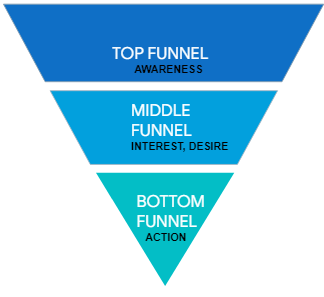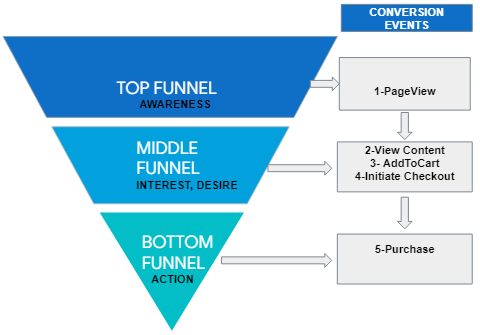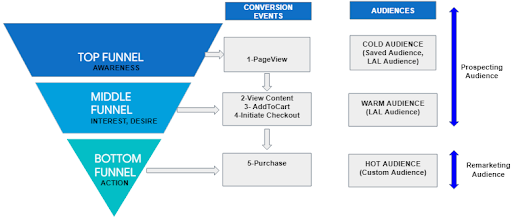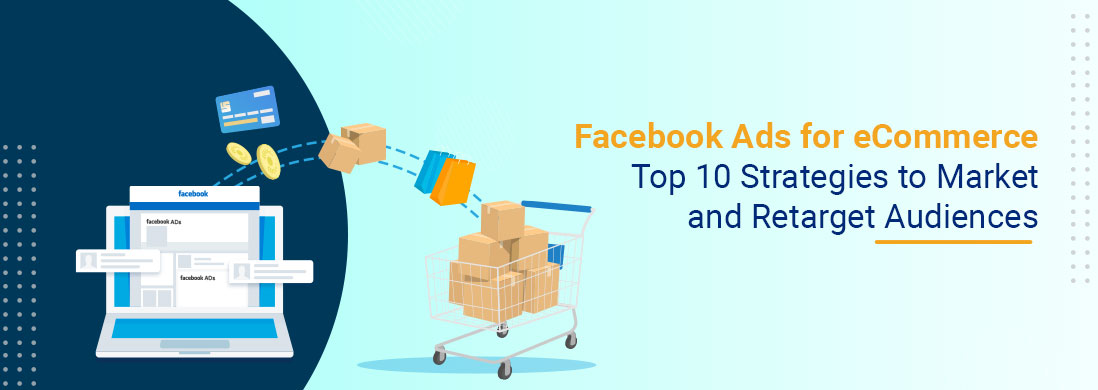Table of Contents
- Facebook Ads for eCommerce
- How to Choose the Right Facebook Ad campaign objective?
- Drop-offs in eCommerce Funnels: How are they reduced?
- Which Facebook Ad Strategies can help Scale eCommerce Business campaigns
- How to Remarket or Retarget Audiences
- Facebook Ads Hacks For Increasing Remarketing Audiences
The Indian eCommerce industry that observed stagnant growth pre-covid; is all set to grow by 84% to $111 billion by 2024. The pandemic proved to be a blessing in disguise as there is an immense increase in the number of eCommerce stores in recent times.
And while the competition is growing, everyone may be wondering: How can Facebook Ads grow their eCommerce business?
Facebook Ads for eCommerce
Among various digital platforms, Facebook has proved to be an effective and incredible tool for eCommerce businesses when done right. These platforms are extremely effective for brand awareness and conversions. This article will help you identify the best optimization strategies to scale up your eCommerce business.
Did You Know?
Facebook has now enabled the ‘shop’ section for Indian users to help customers buy products directly from there. Whereas, the Instagram shop feature is not currently available in India. It is only available for brands that have been selected as ‘Managed Clients’ by Facebook depending on their brand popularity, transparency, and ad content.
How to Choose the Right Facebook Ad campaign objective?

Each campaign has different KPIs (Key Performance Indicators) and deliverables. According to their performance parameters, campaigns fall under different levels of marketing funnels.
1. Awareness: In this funnel, businesses educate their prospects about key offerings and value propositions. They promote their brands or products in such a way that fulfills the ‘Awareness’ funnel.
To achieve this pre-buzz, the Facebook platform has different campaign objectives such as Brand Awareness, Reach.
This objective optimizes the campaign on the following events Ad-recall lift, Reach, and Impressions. The communication at this funnel should aim to portray the unique features of products, key service deliverables and focus on ‘selling’.
2. Interest and Desire. At this level, businesses try to seek the prospects’ attention by creating engaging content and creating a desire to make purchases.
To increase the post-engagement, Facebook platform has different campaign objectives such as Traffic, Engagement, App Installs, Lead generation, Messages, and Video views.
You can optimize the campaign on the following events Link Clicks, Daily Unique Reach, App Installs, Post-Engagement, ThruPlay, Leads, and Page views.
3. Action or Conversion. At this level businesses drive customers to take action by mentioning clear CTA’s (Call To Action) on Facebook Ads. They advertise with promotional content (such as discounts, offers, and benefits).
To improve and enhance conversions, Facebook has different campaign objectives such as Conversions, Catalog Sales, and Store Traffic.
You can optimize the campaign on the following events- Conversion, Value, Conversion events, and Impressions.
Drop-offs in eCommerce Funnels: How are they reduced?

“Conversion rate” is the percentage of site visitors that take the desired action. Final conversion events (Purchases, leads) are preceded by Macro and Micro conversions (Page view, View content, Add2cart). To track conversion on Facebook, Facebook Pixels are implemented on the website.
Funnel Drop Offs:-
(a) Add to Cart Rate: This indicates the % of visitors who placed at least one item in their cart during the session after visiting the product detail page.
Ways to Optimize Add2Cart Rate: Add more customer reviews on product pages, offer discounts to first-time consumers, and introduce a live chatbot.
(b) Cart abandonment rate: This indicates the % of the audiences who add items to an online cart but abandon the cart before completing the purchase.
Ways to Optimize Cart abandonment Rate: Mention clear CTA’s (Call To Actions). Include details like ‘Free Shipping’ and ‘Checkout Discount Code’ in the Description. Use the current product price rather than the listed price in catalog creative format and send persistent reminders of Cart contents.
(c) Initiate Checkout rate: This indicates % the visitors who proceeded to the checkout page after adding an item to the cart.
Ways to Optimize Initiate Checkout Rate: Allow default guest checkouts wherein the customers are not required to create accounts before checkout. Avoid latent and hidden charges. Use creatives that are attractive and have clear communication. Optimize the page loading time and segregate device-wise targeting and the user interface. Mention the CTA that has a sense of urgency.
(d) Checkout conversion rate: This refers to the % of users who begin the checkout process, then complete it over a given time.
Ways to Optimize Checkout conversion Rate: Simplify the checkout process. Add multiple checkout buttons. Secure the checkout process. Minimize details to fill in the checkout form, and Skip the mandatory sign-up.
What Facebook Ad Strategies can help you scale your eCommerce business?

Prospecting Audiences
The audiences that aren’t aware of your business and products. Hence, they fall in the Top Funnel of marketing where businesses need to be aware of their existing offerings. You can target such audiences in the Facebook Ads manager using specific targeting methods, such as
1. Interest audiences
Target them based on their personas, liking, interests, and behavior. Facebook collects ‘consumer insight data’ from the user’s personal information or activities performed on the platform to create these audience segments. These insights are available under the ‘Audience Insights’ and ‘Facebook Analytics’ sections of Ads manager. Facebook recommends targeting prospecting audiences when businesses want to drive traffic to their website with low CPCs (Cost per click).
2. Lookalike Audiences
These are built upon the similar characteristics of our existing seed audiences (audiences that have already interacted with the brand or business). The seed audiences are the ‘Custom audiences’ created from Facebook Pixels. Pixel audiences are the First-party data audiences collected by Facebook from the ‘Meta Sources’ (Facebook, Instagram, Messenger) and ‘Own Sources’ (Website, Apps, Customer List, Offline activities).
Facebook Ads Hacks For Increasing Prospecting Audiences:-
- Brands can target two completely unrelated interests and reflect the same in their ad copies. This has been observed to get more CTR.
- Brands can narrow down their interest targeting with the ‘Must Have’ option, where they can select the interest that is necessary or must for their business. (Like ‘Online shopping’ for their eCommerce business)
- ‘Saved Audiences’ cannot be excluded from any audience set. Hence, analysing the ‘Audience overlapping rate’ is necessary to reduce the chances of the same ads being shown to the repeated user. (Example:- Interest audiences are a subset of Open audiences)
- Different Ad sets can be created targeting different Interest audiences. For example, for eCommerce business, the interests that could be targeted are-
-
- Bargain Hunters (Interested in Discount and sales)
- MediaNEnt (Interested in Entertainment, movies, web series)
- EcommNLabel (Interested in Fashion and Designer brands)
- CompDress (Interested in Direct competitor’s offerings)
- ‘Lookalike Audiences’ can be further narrowed down by adding additional interest, age, and geography targeting.
- Multiple ‘Lookalike audiences’ can be added in a single set unlike ‘Saved audiences’ which can’t be merged. The decision to add various LAL audiences in the same ad set should be taken based on their potential audience reach.
- Ideally 1%-2% Lookalike audience should be used because it has relatively more similarities and the audiences are narrow. Whereas >3% Lookalike Lookalike creates a vague and unrelated audience.
- Lookalike of value-based custom audiences have always been successful in generating higher ROAS or Return on Average spent.
- Different ad sets can be created for LAL audiences. Some of the LAL audiences that can be useful for an eCommerce business are as follows:-
-
- LAL of website visitors
- LAL of customer list (Converted and purchased audiences)
- LAL of Add2cart audiences, Initiate Checkout audiences.
How to Remarket or Retarget Audiences
This includes targeting the audiences that have already interacted with the business and are aware of the business offerings. Specific targeting methods that can be used in Facebook ads manager to approach such audiences are:-
- Use Custom Audiences which are created through Facebook Pixels. The pixels implemented on the website help in identifying the users that had visited your website. Or viewed content, abandoned specific products, initiated checkout, and made final purchase. The pixel also identifies the one that has dropped off in the middle of the funnel. So, we can retarget them from the point where they left off by creating different custom audiences.
Facebook Ads Hacks For Increasing Remarketing Audiences:-
-
- Use ‘Dynamic Remarketing’ to retarget the audience with the particular product they left while making the final purchase. The campaign objective that needs to be selected for it in Ads manager is ‘Catalog sales’. Shopify (or any CRM) feed needs to be linked at the campaign level.
- Always select the ‘Product Tag’ feature for Dynamic Ads. In dynamic ads, the creatives will take the product name and price from the feed. Also, the Landing URL is dynamic to the specific product detail page.
- Different creative tools can be used in the catalog such as the use of Frame (Brand, discount), and strikeout price (in sale catalog). This can help to connect with the users more.
- The use of a proper ‘Primary Text’ and ‘Headline’ is very important in Dynamic Remarketing and Remarketing campaigns. The primary text should have a sense of urgency and should induce the users to complete the pending purchase’. An example of one of the Primary texts that are used in ads is:-
- “We Know You’ve Been Eyeing These Products, So let’s Continue From Where You Left Off ❤”
- There is also an option to ‘Upsell’, or ‘Cross Sell’ in Dynamic Remarketing campaigns which help to promote products to customers who have made certain purchases or abandoned one because of price.
- ‘Custom combination’ of products can also be done in Dynamic Remarketing for specific audiences as per their interaction with the category of products.
Hence…
It is imperative to have a strong and measurable strategy when advertising on Facebook. So the business gets the most value out of it.
Also, a high engagement and conversion rate is observed for brands where they have created ads that are highly targeted. They can be based on the demographic characteristics, interests, and online behavior of their business’ ideal customers.


